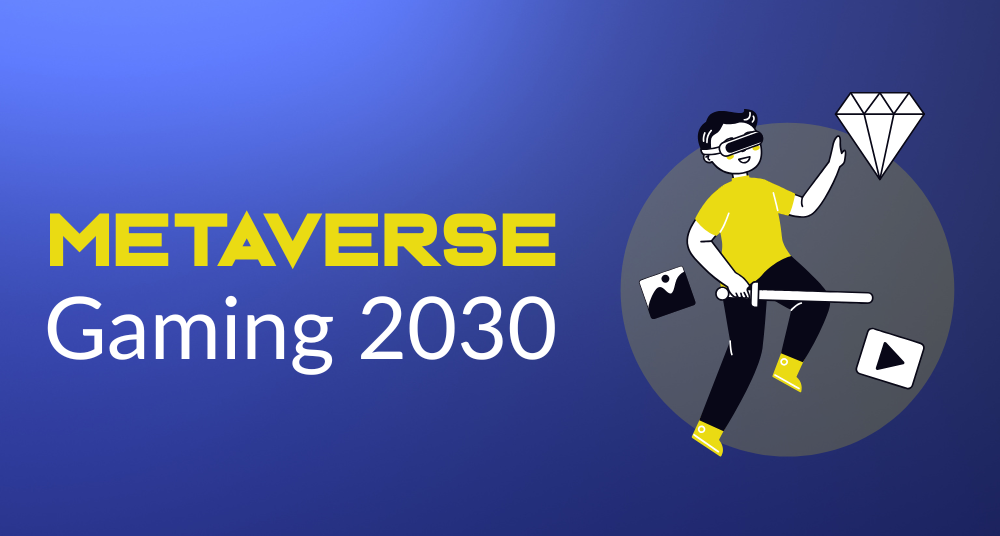According to a recent report by Market Research Future (MRFR), the Metaverse Market was valued at $11.47 billion in 2023 and is projected to reach $107.49 billion by 2030, growing at an astonishing CAGR of 45.2% between 2024 and 2030.
The Metaverse—once just a sci-fi concept—is now rapidly shaping up to become the next evolution of the internet. At its core, the Metaverse is a collective virtual space created through the convergence of digitally enhanced physical realities and persistent virtual environments. It blends technologies like augmented reality (AR), virtual reality (VR), blockchain, and artificial intelligence (AI) to build immersive, interactive digital worlds.
By 2030, the Metaverse is expected to be a fully integrated part of daily life. Users won’t just play games—they’ll live, work, learn, shop, and socialize inside virtual worlds with lifelike avatars, digital assets, and persistent economies. Gaming will be at the heart of this revolution, serving as a gateway for mass adoption.
This guide dives into what Metaverse gaming will look like by 2030, key technologies driving it, emerging platforms, and how businesses and creators can thrive in this new digital frontier.
What is the Metaverse in Gaming?
The Metaverse in gaming refers to immersive, interconnected virtual worlds where players can engage in more than just gameplay. It combines AR, VR, blockchain, and AI to create persistent gaming environments with real-time interaction, digital economies, and customizable avatars. Players can own, trade, and monetize in-game assets across platforms. Unlike traditional games, Metaverse games offer social experiences, live events, and a sense of presence—blurring the line between gaming and reality in a shared digital universe.
The Evolution of Gaming: From Console to Metaverse
Gaming has evolved dramatically over the past few decades—from single-player arcade games and home consoles to cloud gaming and now immersive Metaverse environments. The 1980s introduced us to console gaming with brands like Nintendo and Sega dominating living rooms. In the 2000s, online multiplayer gaming surged, with games like World of Warcraft and Counter-Strike building global communities.
The 2010s gave rise to mobile and cloud gaming, bringing games to every pocket and screen. Today, in the 2020s, we are witnessing the birth of the Metaverse—a shared, persistent, and immersive digital realm where players don’t just game but live virtual lives. Gaming is no longer a passive experience; it’s now social, creative, and economy-driven. The Metaverse is set to redefine gaming as a lifestyle, community, and business.
Key Technologies Powering Metaverse Gaming
AR/VR (Augmented & Virtual Reality)
AR and VR are at the core of immersive Metaverse experiences. VR provides fully simulated environments where players can explore virtual worlds with spatial awareness and presence. AR overlays digital elements onto the real world, creating mixed-reality gameplay. Devices like Meta Quest, Apple Vision Pro, and HoloLens are pushing these boundaries.
Blockchain & NFTs
Blockchain enables secure, decentralized ownership of digital assets. Players can own, trade, or sell NFTs—like skins, weapons, or land—in or outside the game, creating true digital economies.
Artificial Intelligence (AI)
AI powers intelligent NPCs (non-playable characters), real-time language translation, and adaptive game mechanics. It allows games to be more responsive and dynamic, offering unique experiences for each user.
Cloud Computing
Cloud gaming allows high-end gameplay without expensive hardware. With cloud-based rendering and storage, players can access massive Metaverse worlds on various devices with minimal lag.
5G and Edge Computing
5G enables ultra-low latency and faster speeds, essential for seamless Metaverse gaming. Combined with edge computing, it ensures real-time responsiveness and uninterrupted experiences.
Popular Metaverse Gaming Platforms
Roblox
Roblox has evolved from a gaming platform to a creator-centric Metaverse hub where players build, monetize, and socialize through interactive worlds.
The Sandbox
Built on Ethereum, The Sandbox empowers users to create games and experiences using voxel-based assets and monetize them through NFTs and its native token $SAND.
Decentraland
A fully decentralized virtual world where users can buy land, host events, and build anything from casinos to art galleries using $MANA tokens.
Fortnite by Epic Games
More than a battle royale, Fortnite is transitioning into a social Metaverse where players attend concerts, watch trailers, and engage in cross-franchise experiences.
Others on the Rise
Platforms like Meta’s Horizon Worlds, Spatial.io, and newer AI-integrated gaming spaces are expected to dominate the landscape by 2030.
In-Game Economies and Digital Assets
The Metaverse introduces real-world economics into virtual spaces. Players now earn through:
- Play-to-Earn (P2E) models where in-game performance leads to real rewards.
- NFTs representing unique items—like weapons, wearables, land, and even pets—that hold tangible value.
- DAOs (Decentralized Autonomous Organizations) that allow players to vote on in-game policies or development decisions.
- Interoperable assets which can move across different games or Metaverse platforms, empowering a global virtual economy.
These economies are not just features—they are fundamental to how players engage and invest in games.
Social & Community-Driven Gameplay
Gaming is no longer a solo or limited multiplayer activity. Metaverse games prioritize:
Virtual hangouts & events: Concerts, movie screenings, and community events held inside games.
Avatar-based interactions: Personalized avatars as digital extensions of users, enabling deeper social expression.
Guilds and communities: Players form alliances, participate in group missions, and govern their own communities.
Content creation: Players co-create games, skins, music, and entire environments, fostering a creator-first economy.
Gaming in the Metaverse is about building relationships and communities—not just beating levels.
Monetization in Metaverse Gaming
The Metaverse has unlocked diverse revenue models:
Play-to-Earn (P2E): Gamers earn cryptocurrency or NFTs by completing challenges or contributing to the ecosystem.
GameFi & Staking: Players can stake tokens to earn passive income, participate in governance, or gain access to premium features.
Digital Real Estate: Buying, renting, and selling virtual land is now a major stream of income for early adopters.
Brand Collaborations: Brands like Nike and Gucci are building digital assets and spaces, tapping into massive in-game audiences.
Creator Royalties: Game creators and designers earn ongoing royalties from secondary sales of NFTs or user-generated content.
Monetization in the Metaverse is democratized—open to players, developers, artists, and brands.
Challenges & Ethical Considerations
Despite the excitement, Metaverse gaming brings challenges:
Data Privacy & Security: User data, digital wallets, and identity must be safeguarded in decentralized environments.
Digital Addiction: Highly immersive spaces may lead to overuse and real-world detachment, especially among younger users.
Economic Disparity: Those who can afford premium NFTs or land may dominate gameplay and profits, creating inequality.
Moderation & Regulation: Harassment, cheating, and financial fraud need robust moderation tools and legal frameworks.
Environmental Concerns: Blockchain-based games using proof-of-work can have high carbon footprints (though moving to proof-of-stake helps).
Addressing these issues will be key to sustainable Metaverse gaming.
What to Expect by 2030
By 2030, Metaverse gaming will be:
Hyper-immersive: Full-body haptics, voice-controlled NPCs, and eye-tracking for ultra-realistic gameplay.
Cross-platform and persistent: Avatars, progress, and assets will follow users across devices and games.
AI-driven storytelling: Games will adapt storylines based on player behavior and preferences.
Virtual jobs and careers: Roles like virtual real estate agents, avatar designers, and in-game event planners will be commonplace.
Mainstream adoption: With better access and tech affordability, Metaverse gaming will become a part of daily digital life for millions.
How Developers and Investors Can Prepare
For Developers:
Learn Web3 Tools: Familiarize with Unity, Unreal Engine, blockchain SDKs, and NFT frameworks.
Focus on Interoperability: Build games that can interact with other platforms and economies.
Design for Community: Add social layers, customization, and monetization to boost engagement.
For Investors:
Support emerging platforms: Early-stage Metaverse games offer high ROI potential.
Diversify assets: Spread investments across land, tokens, and NFTs across trusted platforms.
Follow market sentiment: Pay attention to shifts in user behavior, tech innovation, and regulation trends.
Frequently Asked Questions [FA’QS]
Will Metaverse gaming replace traditional games by 2030?
Not completely. While Metaverse gaming will grow significantly, traditional gaming formats (console, PC, mobile) will still exist. Expect hybrid experiences that merge both worlds.
What devices will people use for Metaverse gaming in 2030?
By 2030, Metaverse gaming will be accessible via advanced VR headsets, AR glasses, haptic suits, and even brain-computer interfaces—yet still supported on mobile and PC for wider reach.
Can gamers earn real money in the Metaverse?
Yes. Through play-to-earn models, NFT trading, virtual real estate, and creator royalties, many gamers will generate full-time incomes inside Metaverse ecosystems.
Are digital assets like land and NFTs in Metaverse games safe to invest in?
They hold real value, but come with risks. By 2030, improved blockchain security and global regulations are expected to make Metaverse asset investments safer and more transparent.
Will avatars and assets work across different Metaverse platforms?
Yes, interoperability is a major goal. Avatars, inventory, and currency will increasingly be usable across multiple games and worlds by 2030.
How will Metaverse gaming impact real-life social interaction?
It will enhance global connectivity and community-building but also raise concerns around screen time and addiction. Game designers will need to balance engagement with user well-being.
Related Guide: Metaverse in 2030: An Insider Guide
Final Thoughts: The Future of Play
Metaverse gaming is not just a trend—it’s a paradigm shift in how we experience digital worlds. As we approach 2030, we’re heading toward a future where games are more than entertainment; they’re ecosystems, economies, and social hubs. For players, it means deeper immersion. For creators and investors, it means limitless opportunity. For the world, it’s the dawn of a new digital reality where play, work, and life converge.






What do you think?
It is nice to know your opinion. Leave a comment.